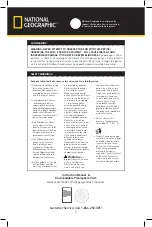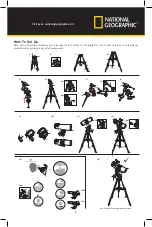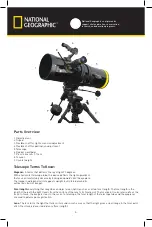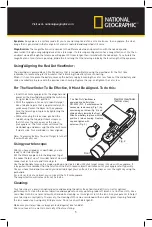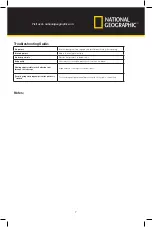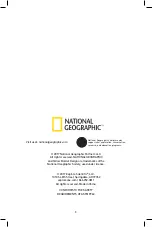
5
Eyepiece:
An eyepiece is a system made for your eye and comprised of one or more lenses. In an eyepiece, the clear
image that is generated in the focal point of a lens is captured and magnified still more.
Magnification:
The magnification corresponds to the difference between observation with the naked eye and
observation through a magnifying device like a telescope. If a telescope configuration has a magnification of 30x, then
an object viewed through the telescope will appear 30 times larger than it would with the naked eye. To calculate the
magnification of your telescope setup, divide the focal length of the telescope tube by the focal length of the eyepiece.
Using/Aligning the Red Dot Viewfinder:
The viewfinder is powered by a CR-2032 battery that is included. Before using the viewfinder for the first time,
remember to remove the plastic insulator that is blocking the battery from connecting.
When it is time to replace the battery, remove the battery cap by loosening the set screw. Take out the old battery and
slide a new battery in place with the positive side showing. Replace the cap, and tighten the set screw.
For The Viewfinder To Be Effective, It Must Be Aligned. To do this:
• Insert the 20mm eyepiece into the diagonal and
power on the viewfinder by sliding the switch on
its right side to an “On” position.
• Point the eyepiece at an easy to identify target
like a telephone pole that is approximately 200
yards away. Center the object in the eyepiece.
Lock the telescope into place by tightening the
panhandle.
• Without moving the telescope, position the
red dot using the two adjustment screws so
that it shares the same view as the one in
your eyepiece. The front screw will move the
viewfinder up and down, and the other will move
it side to side. Your viewfinder is now aligned.
Note: To preserve battery life, don’t forget to turn off
the viewfinder after use.
Using your telescope:
After you have aligned your viewfinder, you are
ready to start observing!
Put the 20mm eyepiece into the diagonal to get
the widest field of view. This wider field of view will
make it easier to locate and track objects.
Use the panhandle to move the scope up, down and side to side until your target comes into view in the eyepiece. It
is important to remember that the rotation of the Earth means objects will move out of your eyepiece fairly quickly.
Once you have found and focused on your desired target, you can track it as it journeys across the night sky using the
panhandle.
For a closer look at an object, you can insert the 12.5mm eyepiece.
The magnification will increase from 30x to 48x.
Cleaning:
Your telescope is a precision optical device and keeping the optics free of dust and dirt is crucial for optimal
performance. To clean the lenses (objective and eyepiece) use only a photo-grade soft brush or a lint-free cloth, like a
microfiber cloth. Do not press down too hard while cleaning, as this might scratch the lens. Ask your parents to help if
your telescope is really dirty. f necessary, the cleaning cloth can be moistened with an optical glass cleaning fluid and
the lens wiped clean using very little pressure. Do not use harsh detergents!
Make sure your telescope is always protected against dust and dirt.
After use, leave it in a warm room to dry off before storing.
The Red Dot Viewfinder is
powered by a battery type
CR-2032 (3V); if a replacement is
necessary, remove cap (Fig. 1) by
unscrewing set screw (Fig. 2) and
sliding battery towards the front.
Slide new battery in place with the
positive (+) side showing. Replace
cap and tighten with
set screw (Fig. 2).
Fig. 1
Fig. 2
Front
Red Dot Viewfinder
(bottom view)
El Visor Red Dot es
impulsado por un tipo de batería
CR-2032 (3V); si un reemplazo es
necesario, retire la tapa (fig. 1),
desenroscando el tornillo de ajuste
(fig. 2) y la batería de deslizamiento
hacia la parte delantera. Deslice la
pila en el lugar con la positiva
proyección lateral (+). Reemplace
la tapa y apriete con
el tornillo de
fijación (fig. 2).
fig. 1
fig. 2
frente
Red Dot visor
(vista desde abajo)
English
Le Dot Viseur rouge est
alimenté par une batterie de type
CR-2032 (3V), si un remplacement
est nécessaire, enlever le bouchon
(Fig. 1) en dévissant la vis de
réglage (Fig. 2) et la batterie de
glissement vers l'avant. Glisser la
nouvelle pile en place avec la
borne positive (+) côté montrant.
Remettre le bouchon et
le serrer avec
la vis de
pression
(Fig. 2).
Fig. 1
Fig. 2
de devant
Red Dot Viseur
(vue de dessous)
French
Spanish
Visit us at:
nationalgeographic.com


